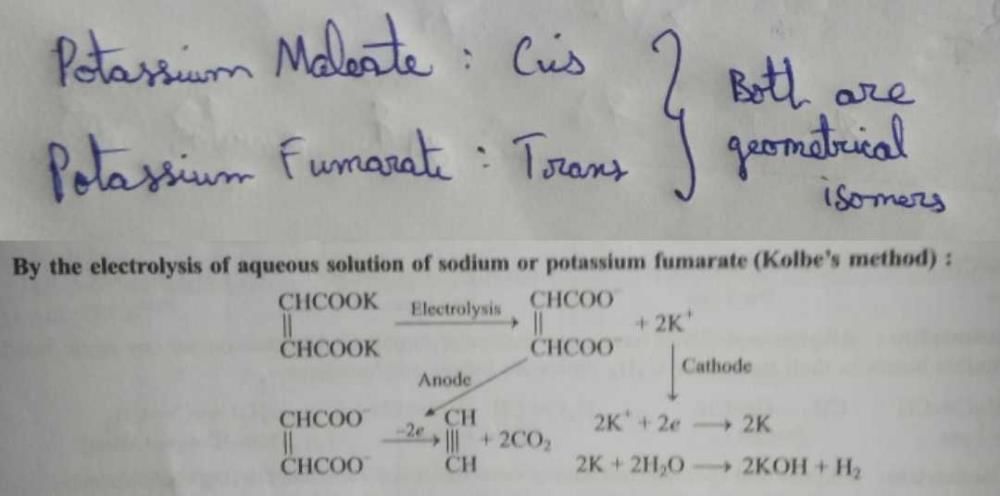Class 11 Exam > Class 11 Questions > Water product is obtained on electrolyzing po...
Start Learning for Free
Water product is obtained on electrolyzing potassium fumarate
- a)C2H6
- b)C2H2
- c)C2H4
- d)CH4
Correct answer is option 'B'. Can you explain this answer?
Verified Answer
Water product is obtained on electrolyzing potassium fumaratea)C2H6b)C...
C2H2 is formed.
Most Upvoted Answer
Water product is obtained on electrolyzing potassium fumaratea)C2H6b)C...

Free Test
FREE
| Start Free Test |
Community Answer
Water product is obtained on electrolyzing potassium fumaratea)C2H6b)C...
There seems to be a mistake in the given information. Potassium fumarate (C4H2K2O4) is not directly related to the production of water through electrolysis. Electrolysis is a chemical process in which an electric current is used to break down a compound into its constituent elements. In the case of water (H2O), electrolysis can be used to separate it into hydrogen gas (H2) and oxygen gas (O2).
However, if we assume that the given compound is actually potassium formate (HCOOK), then we can explain the answer. Potassium formate can be electrolyzed to produce water and carbon dioxide gas.
Here is an explanation of the process:
1. Electrolysis of Potassium Formate:
- When an electric current is passed through an aqueous solution of potassium formate, the compound undergoes electrolysis.
- At the anode (positive electrode), oxidation occurs, and oxygen gas is produced:
2HCOOK(aq) -> 2CO2(g) + 2H2O(l) + O2(g) + 4e^-
- At the cathode (negative electrode), reduction occurs, and hydrogen gas is produced:
4H2O(l) + 4e^- -> 4OH^-(aq) + 2H2(g)
2. Formation of Water:
- The reduction reaction at the cathode results in the formation of hydroxide ions (OH^-) and hydrogen gas (H2).
- The hydroxide ions can react with the hydrogen ions (H+) from the potassium formate to produce water (H2O):
4OH^-(aq) + 4H+(aq) -> 4H2O(l)
Therefore, the correct answer is option 'B' (C2H2) if the given compound is potassium formate (HCOOK). Electrolyzing potassium formate would result in the production of water (H2O) along with carbon dioxide gas (CO2).
However, if we assume that the given compound is actually potassium formate (HCOOK), then we can explain the answer. Potassium formate can be electrolyzed to produce water and carbon dioxide gas.
Here is an explanation of the process:
1. Electrolysis of Potassium Formate:
- When an electric current is passed through an aqueous solution of potassium formate, the compound undergoes electrolysis.
- At the anode (positive electrode), oxidation occurs, and oxygen gas is produced:
2HCOOK(aq) -> 2CO2(g) + 2H2O(l) + O2(g) + 4e^-
- At the cathode (negative electrode), reduction occurs, and hydrogen gas is produced:
4H2O(l) + 4e^- -> 4OH^-(aq) + 2H2(g)
2. Formation of Water:
- The reduction reaction at the cathode results in the formation of hydroxide ions (OH^-) and hydrogen gas (H2).
- The hydroxide ions can react with the hydrogen ions (H+) from the potassium formate to produce water (H2O):
4OH^-(aq) + 4H+(aq) -> 4H2O(l)
Therefore, the correct answer is option 'B' (C2H2) if the given compound is potassium formate (HCOOK). Electrolyzing potassium formate would result in the production of water (H2O) along with carbon dioxide gas (CO2).

|
Explore Courses for Class 11 exam
|

|
Similar Class 11 Doubts
Water product is obtained on electrolyzing potassium fumaratea)C2H6b)C2H2c)C2H4d)CH4Correct answer is option 'B'. Can you explain this answer?
Question Description
Water product is obtained on electrolyzing potassium fumaratea)C2H6b)C2H2c)C2H4d)CH4Correct answer is option 'B'. Can you explain this answer? for Class 11 2025 is part of Class 11 preparation. The Question and answers have been prepared according to the Class 11 exam syllabus. Information about Water product is obtained on electrolyzing potassium fumaratea)C2H6b)C2H2c)C2H4d)CH4Correct answer is option 'B'. Can you explain this answer? covers all topics & solutions for Class 11 2025 Exam. Find important definitions, questions, meanings, examples, exercises and tests below for Water product is obtained on electrolyzing potassium fumaratea)C2H6b)C2H2c)C2H4d)CH4Correct answer is option 'B'. Can you explain this answer?.
Water product is obtained on electrolyzing potassium fumaratea)C2H6b)C2H2c)C2H4d)CH4Correct answer is option 'B'. Can you explain this answer? for Class 11 2025 is part of Class 11 preparation. The Question and answers have been prepared according to the Class 11 exam syllabus. Information about Water product is obtained on electrolyzing potassium fumaratea)C2H6b)C2H2c)C2H4d)CH4Correct answer is option 'B'. Can you explain this answer? covers all topics & solutions for Class 11 2025 Exam. Find important definitions, questions, meanings, examples, exercises and tests below for Water product is obtained on electrolyzing potassium fumaratea)C2H6b)C2H2c)C2H4d)CH4Correct answer is option 'B'. Can you explain this answer?.
Solutions for Water product is obtained on electrolyzing potassium fumaratea)C2H6b)C2H2c)C2H4d)CH4Correct answer is option 'B'. Can you explain this answer? in English & in Hindi are available as part of our courses for Class 11.
Download more important topics, notes, lectures and mock test series for Class 11 Exam by signing up for free.
Here you can find the meaning of Water product is obtained on electrolyzing potassium fumaratea)C2H6b)C2H2c)C2H4d)CH4Correct answer is option 'B'. Can you explain this answer? defined & explained in the simplest way possible. Besides giving the explanation of
Water product is obtained on electrolyzing potassium fumaratea)C2H6b)C2H2c)C2H4d)CH4Correct answer is option 'B'. Can you explain this answer?, a detailed solution for Water product is obtained on electrolyzing potassium fumaratea)C2H6b)C2H2c)C2H4d)CH4Correct answer is option 'B'. Can you explain this answer? has been provided alongside types of Water product is obtained on electrolyzing potassium fumaratea)C2H6b)C2H2c)C2H4d)CH4Correct answer is option 'B'. Can you explain this answer? theory, EduRev gives you an
ample number of questions to practice Water product is obtained on electrolyzing potassium fumaratea)C2H6b)C2H2c)C2H4d)CH4Correct answer is option 'B'. Can you explain this answer? tests, examples and also practice Class 11 tests.

|
Explore Courses for Class 11 exam
|

|
Signup for Free!
Signup to see your scores go up within 7 days! Learn & Practice with 1000+ FREE Notes, Videos & Tests.
























